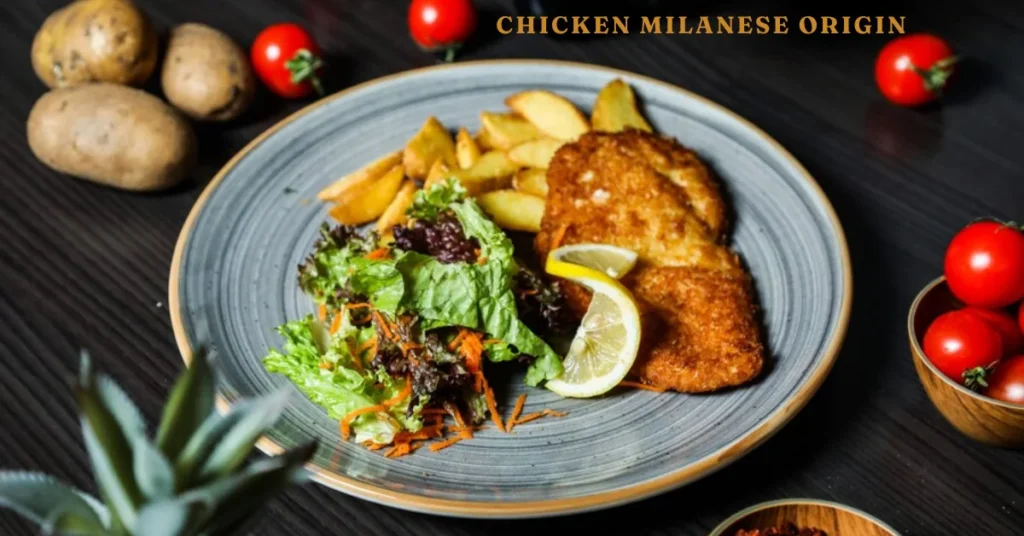Introduction to Chicken Milanese
Chicken Milanese origin is more than just a dish; it’s a delightful culinary journey that embodies comfort and tradition. This crispy, golden-brown chicken cutlet has captured hearts worldwide, but its roots trace back to Italy. As you savor each bite, you’re not just enjoying a meal—you’re experiencing a slice of cultural history. The delicate balance of seasoned breadcrumbs mingling with tender chicken creates an irresistible harmony that begs to be explored further. Join us as we uncover the origins of Chicken Milanese and delve into how this beloved dish made its way from Italian kitchens to dining tables across the Americas, evolving along the way into various delicious adaptations.
The History of Chicken Milanese Origin
Chicken Milanese Origin traces its roots back to Italy, where it is a beloved dish in many households. Traditionally made with veal, the name “Milanese” comes from the city of Milan. Its classic preparation involves breading and frying thin slices of meat until golden and crispy.
As Italian immigrants journeyed to the Americas in the late 19th and early 20th centuries, they brought their culinary traditions along. Adapting to local ingredients and preferences led to variations using chicken instead of veal. This shift not only made it more accessible but also introduced new flavors.
In America, Chicken Milanese became a staple on restaurant menus, celebrated for its simplicity and rich flavor profile. It reflects how food evolves when cultures intersect, creating delicious fusions that appeal to diverse palates across generations. The dish tells a story—one of migration, adaptation, and enduring love for good food.
Authentic Italian Recipe vs. American Adaptations
The authentic Italian version of Chicken Milanese is a true celebration of simplicity. Tender chicken breasts are pounded thin, coated in breadcrumbs, and fried to golden perfection. The emphasis here is on quality ingredients—fresh herbs, high-quality olive oil, and possibly Parmigiano-Reggiano for added flavor.
In contrast, American adaptations often embrace creativity. While the basic elements remain intact, you might encounter variations featuring spices or even different types of breading like panko for extra crunch. Some recipes call for richer sauces or toppings that transform this classic into something distinctly American.
Garnishes also diverge between the two cultures. Italians may finish their dish with a squeeze of lemon and fresh arugula while Americans might opt for marinara sauce or even cheese-laden accompaniments. Each version tells a story about its origins and influences yet maintains the heart of what makes Chicken Milanese so beloved across continents.
ALSO READ: The Flavorful World of Çeciir: Turkey’s Culinary Gem
Variations of Chicken Milanese in Different Countries
Chicken Milanese has taken on various forms as it traveled around the globe. Each culture adds its own twist, creating unique flavors and textures.
In Argentina, for instance, you’ll find “milanesa de pollo” served with a side of mashed potatoes or salad. The locals often enjoy it topped with a fried egg or even cheese, making it an indulgent treat.
Crossing over to Brazil introduces “filé à milanesa,” where chicken is coated in breadcrumbs and then deep-fried to achieve that golden crispiness. It’s typically accompanied by rice and beans.
In Germany, they have their version called “Schnitzel,” which can feature chicken but is more commonly made from pork veal. Though different in meat choice, the preparation methods share similarities with the original Italian dish.
Each adaptation reflects local tastes while honoring this beloved classic—a true testament to its versatility across cultures.
How to Make the Perfect Chicken Milanese
To craft the perfect Chicken Milanese, start with thinly sliced chicken breasts. A light pounding helps achieve that signature tenderness.
Next, prepare three separate bowls. Fill one with seasoned flour, another with beaten eggs, and the last with breadcrumbs mixed with Parmesan cheese for added flavor.
Dredge each chicken piece in flour first. Shake off any excess before dipping it into the egg mixture. The final step is to coat it thoroughly in breadcrumbs. Make sure every inch is covered for a crispy finish.
Heat oil in a skillet over medium-high heat. Once hot, carefully place your breaded chicken pieces into the pan. Cook until golden brown on both sides—around 3-4 minutes per side should do it.
When done, let them rest briefly on paper towels to absorb excess oil before serving. This ensures they remain delightfully crisp!
ALSO READ: Soymamicoco: Taste the Fusion of Soy, Matcha, and Coconut
Popular Side Dishes and Drinks to Pair with Chicken Milanese
Chicken Milanese is delightful on its own, but pairing it with the right sides and drinks elevates the meal. A fresh arugula salad drizzled with lemon vinaigrette adds a peppery contrast that complements the crispy chicken.
For something heartier, try roasted potatoes tossed in herbs. Their fluffy insides and golden crust provide a satisfying texture alongside the crunchy Milanese.
When it comes to beverages, consider a light white wine like Pinot Grigio or Sauvignon Blanc. These wines enhance the dish without overpowering its flavors.
If you’re looking for non-alcoholic options, sparkling water with a splash of citrus can cleanse your palate beautifully. Each pairing creates an experience that celebrates this classic dish while respecting its Italian roots.
Conclusion: Why Chicken Milanese Origin Stands the Test of Time
Chicken Milanese origin has transcended its humble Italian roots to become a beloved dish across the globe. Its simplicity and versatility have made it adaptable, allowing variations that cater to diverse tastes while maintaining its essence. The crispy golden exterior combined with tender chicken makes it irresistible.
The cultural journey of Chicken Milanese reflects broader culinary trends as traditions blend and evolve over time. Whether it’s enjoyed in an upscale restaurant or at a family gathering, this dish brings comfort and joy. With regional adaptations showcasing local ingredients, Chicken Milanese continues to inspire chefs and home cooks alike.
As we savor each bite of this iconic meal, we appreciate not only its rich history but also the connections it fosters around the dining table. This timeless classic remains a testament to how food can unite us all—an everlasting favorite that will likely grace dinner plates for generations to come.
ALSO READ: Buší: A Flavorful Slow-Cooked Delight
FAQs
What is the origin of Chicken Milanese?
Chicken Milanese originates from Italy, inspired by the traditional veal Milanese from Milan. Italian immigrants later adapted it using chicken, and the dish spread across the Americas.
How did Chicken Milanese become popular in America?
Italian immigrants brought the recipe to America in the late 19th and early 20th centuries. Its simplicity and delicious flavor quickly made it a favorite on American menus.
What is the difference between Chicken Milanese and Wiener Schnitzel?
While both dishes involve breaded and fried meat, Chicken Milanese is made with chicken (or veal originally) and is Italian in origin, whereas Wiener Schnitzel traditionally uses veal and hails from Austria.
Are there variations of Chicken Milanese in other countries?
Yes, Chicken Milanese has variations worldwide, such as Argentina’s “milanesa de pollo” often topped with a fried egg, and Brazil’s “filé à milanesa” served with rice and beans.
What are some classic side dishes to serve with Chicken Milanese?
Classic sides include a fresh arugula salad with lemon vinaigrette or herb-roasted potatoes. Pair it with a light white wine like Pinot Grigio for a perfect meal.






